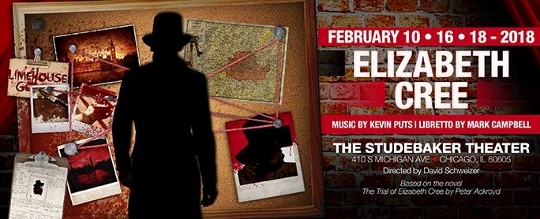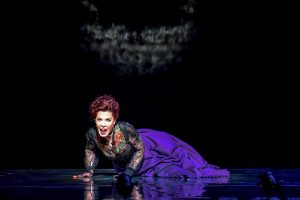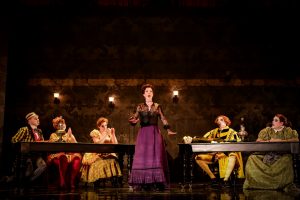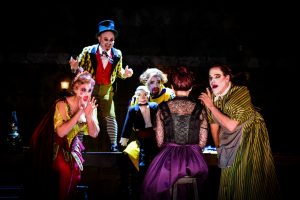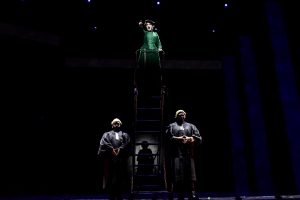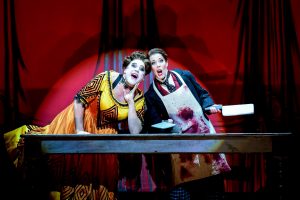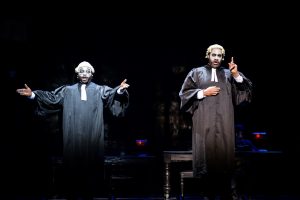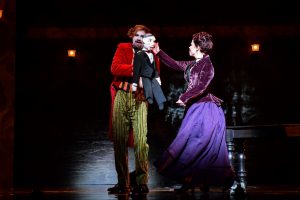A PENNY DREADFUL FOR YOUR THOUGHTS
Murder will out, whether in police gazettes or chamber opera. If he hadn’t existed, the still unknown Jack the Ripper could have been invented by penny dreadfuls, the Victorian tabloids that fed on fear and treated murder like a lark. At the same time melodramas trafficked in Grand Guignol exaggerations of Punch-and-Judy domestic violence, the meat-procurer Sweeney Todd, or the wife-killing Mr. Bluebeard. (The musical Chicago hardly invented the cell-to-stage success story.) Madame Tussaud turned notorious killers into waxworks. Why not an opera based on a sardonic novel that shows how art apes life or, more properly, death?
From composer Keven Puts and librettist Mark Campbell, creators of the well-received 2012 Pulitzer Prize-winner Silent Night, comes Elizabeth Cree, a conflation of popular culture and even more popular crime. A co-production by Opera Philadelphia and Chicago Opera Theater now playing the Studebaker Theater, this wicked work, drawn from the novel by Peter Ackroyd, chronicles the career and demise of the title character. From the start there’s no doubt about her fate: We see a female dangling from a noose. It’s 1881 when Mrs. Elizabeth Cree gets hanged at Camberwell Prison for poisoning her wealthy playwright/critic husband John with arsenic.
How did this lonely lady from London’s East End reach the scaffold? As the skittishly chronological libretto discloses, Elizabeth joins a music-hall troupe much like the circus folk in Dickens’ Hard Times, complete with famous comedian Dan Leno, as well as a ventriloquist, wire-walker, magician, and balladeer called the Wide-Eyed Warbler. In 1879 Elizabeth finds brief success as “Lambeth Marsh Lizzie.” But fame fleets and Lizzie leaves this surrogate family of scrappy vaudevillians for a fashionable marriage to the eligible but enigmatic John Cree. Escaping propriety, in her ultimate “trousers role,” Elizabeth likes to wander the streets of London disguised as a handsome young man.
Paralleling Elizabeth’s rags-to-riches social climbing and her increasingly loveless marriage are sickening revelations from her husband’s presumed diary, so much Gothic horror on steroids. Moving from peppy burlesque numbers, Puts’ score darkens indeed to depict the predations of “The Limehouse Golem” stalker-slaughterer.
This monster indulges in elaborately grisly eviscerations where he imagines he’s freeing his corpses from the coils of mortality: To him they’re all mercy killings. When he’s not prowling badly lit back alleys, the serial slayer hangs out in the Reading Room of the British Museum with the likes of Karl Marx and novelist George Gissing. The creature is working on a novel called Misery Junction about a poor girl who makes good. Camouflaged in florid sentiment, it hardly reflects the fiend’s butchering of marginalized victims like the meek Hebrew scholar Solomon Weil.
Strategically alternating with flashbacks, courtroom scenes from Elizabeth’s trial for murder connect the Crees’ seemingly divergent paths. Will the late Lizzie be immortalized as “The Woman Who Was There” just as Kander and Ebb did the merry murderers of Cook County Jail? You betcha.
But it’s not just the opera’s twisted rhythms and quicksilver moodiness that set us ajar. Playing on our prejudices, the plot spins a wrenching reversal that’s as gripping, if not convincing, as any earlier evil. The (sick) joke is on the audience. You may not find this “attitude adjustment” enlightening.
But there’s no discounting the skill sets of everyone connected with David Schweizer’s staging and Geoff McDonald’s musical direction. That begins and ends with the disconcertingly lovely Katherine Pracht: Her Elizabeth finds all the furtive lyricism she can in Puts’ minor notes and sepulchral chords. Christopher Burchett as the magisterial John Cree revels in his complex character’s double life, well established in the contrasting tones of his anguished arias.
The other ten performers honor their stereotypes with precision and panache, with clever cameos by Vince Wallace and Bill McMurray as dueling barristers and Stacey Tappan as Elizabeth’s strangely sweet alter ego. David Govertsen brings avuncular devotion to Lizzie’s showbiz protector. Lighting designer Alexander V. Nichols’ wizard projections create constantly chilling backdrops.
Refracting and distorting its own artistry, Elizabeth Cree is very much an “inside job,” both accusation and exploitation of our larcenous lusts and our fascination with other people’s suffering. But, however spellbinding and sinister, ninety-five minutes of this pretty poison, with its contagious Schadenfreude, deliver deadly goods that strain the brain.
photos by Evan Hanover
Elizabeth Cree
Chicago Opera Theater
Studebaker Theater, 410 S. Michigan Ave.
ends on February 18, 2018
for tickets call 312.704.8414 or visit COT
